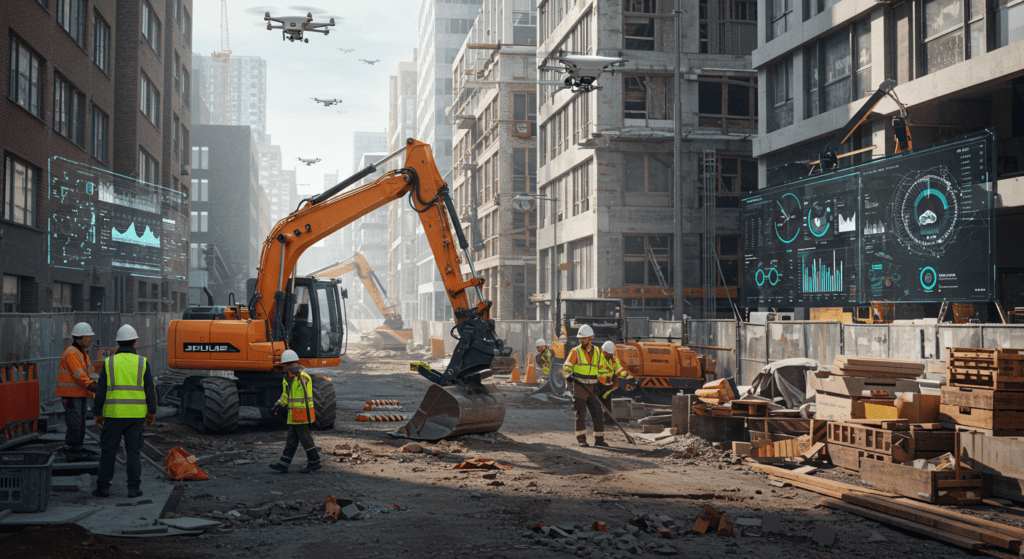- Evolving Construction Risks and the Need for Enhanced Coverage
- The Impact of Technological Innovation on Construction Insurance
- The Role of Data Analytics and AI in Risk Assessment
- Emerging Trends in Construction Safety and Policy
- Digital Transformation: Tools Shaping the Future of Insurance
- Regulatory Changes and Their Implications for Insurers
- Sustainable Practices and Green Construction Trends
- The Future of Claims Processing and Customer Experience
- Preparing for Tomorrow: Strategies for the Modern Construction Insurer
The construction industry is transforming rapidly, and with it, the insurance sector is reinventing its approach. In this era of dynamic change and technological evolution, construction insurance is under pressure to develop solutions that address emerging risks while leveraging innovative tools. Today’s insurers must remain agile, integrating cutting-edge developments and practices to meet the needs of an industry that continually pushes the boundaries of design, engineering, and environmental responsibility.

1. Evolving Construction Risks and the Need for Enhanced Coverage
Modern construction projects are characterized by complex supply chains, increasingly intricate structures, and new materials that challenge traditional safety standards. Heightened global competition and the pressures imposed by rapid urban development mean that potential risks—from on-site accidents to environmental liabilities—are more pronounced. Insurers are therefore compelled to review and enhance coverage options that not only address conventional hazards but also the multifaceted and evolving nature of the construction environment. A forward-thinking approach to policy design helps mitigate losses and fosters trust between insurers and stakeholders in the construction process.
2. The Impact of Technological Innovation on Construction Insurance
Breakthroughs in technology have redefined the landscape of risk management. Innovations such as Building Information Modeling (BIM), drones for site inspections, and sensor technology are transforming how risk is assessed and managed. These tools generate high-resolution, real-time data, enabling insurers to identify potential problem areas early. In doing so, technology helps reduce claims and improves project safety. As a result, insurance companies can better price premiums and tailor services to meet the unique demands of each construction project. Technological integration is not just about efficiency; it is a critical step towards more precise risk management in an industry that must constantly adapt to new challenges.

3. The Role of Data Analytics and AI in Risk Assessment
Data analytics and artificial intelligence (AI) have emerged as critical components in the evolution of construction insurance. By analyzing historical claims data and real-time inputs from job sites, AI tools predict risk probabilities with increasing precision. Advanced algorithms detect patterns and anomalies that may indicate future claims or safety issues, allowing insurers to tailor policies and provide proactive risk management advice. This transformative approach not only results in more accurate underwriting but also enhances trust between insurers, contractors, and the insured parties. As the volume and complexity of data continue to increase, insurers who invest in these capabilities will have a competitive edge in crafting bespoke, responsive policies.
4. Emerging Trends in Construction Safety and Policy
Safety is the cornerstone of construction insurance, and evolving policy trends are now emphasizing preventative measures as much as reactive coverage. New policies integrate safety training, risk prevention programs, and incentives for clients who adopt the latest safety technologies on job sites. These policies encourage the use of best practices, reducing the likelihood of accidents and environmental hazards. Trends in safety protocols are also influencing regulatory standards, pushing the industry toward more holistic, sustainable practices. By aligning insurance products with these trends, insurers are not only helping to safeguard lives and property but are also reducing the frequency and severity of claims.
5. Digital Transformation: Tools Shaping the Future of Insurance
Digital transformation is fundamentally reshaping how insurers communicate, manage data, and process claims. Mobile apps and cloud-based platforms allow for instant communication between insurers and policyholders, ensuring rapid response in times of crisis. These digital tools have also revolutionized claims processing by streamlining the steps required for validation and settlement. Additionally, virtual reality and augmented reality programs are increasingly used for training, remote inspections, and risk assessment, permitting a level of safety analysis that was unimaginable only a few years ago. As these innovations take center stage, the future of construction insurance is becoming more agile, efficient, and customer-centric.

6. Regulatory Changes and Their Implications for Insurers
The regulatory environment is continually adapting to the rapid pace of technological and operational changes in the construction industry. New regulations governing safety standards, environmental impact, and workers’ compensation directly influence how insurers develop coverage. With regulators emphasizing the importance of digital records and real-time reporting, insurers are forced to adopt robust systems to maintain compliance. Moreover, international standards and cross-border regulations require companies to stay informed about global best practices and adjust their policies accordingly. Proactive engagement with regulatory bodies is now crucial as insurers navigate a complex landscape where compliance and competitive innovation go hand in hand.
7. Sustainable Practices and Green Construction Trends
Sustainability has become integral to construction practices, influencing everything from building design to material selection. Insurers are now incorporating sustainability into their risk models by recognizing that green construction often leads to fewer environmental risks and enhanced structural longevity. Coverages are being designed with incentives for projects that pursue energy efficiency, renewable resource use, and minimal environmental impact. This embrace of green practices not only contributes to lower policy claims due to fewer incidents but also appeals to a growing market of environmentally conscious builders and investors. The shift towards sustainable construction represents a win-win scenario, combining reduced risks with improved environmental and financial performance.

8. The Future of Claims Processing and Customer Experience
Claims processing is evolving toward faster, more accurate resolutions driven by digital technologies and refined analytics. Automated systems using AI can quickly review, verify, and adjudicate claims, significantly reducing the time needed for settlement. Furthermore, digital platforms allow customers to monitor the progress of their claims in real time, fostering transparency and trust. This enhanced customer experience translates into greater satisfaction and loyalty, features that are becoming increasingly vital in a competitive insurance market. The agility of digital claims systems not only streamlines operations but also allows insurers to respond proactively to emerging risks, thereby improving overall industry standards.
9. Preparing for Tomorrow: Strategies for the Modern Construction Insurer
Insurers that wish to thrive in the future of construction insurance must adopt a multifaceted strategic approach. Investments in technology, data analytics, and regulatory compliance are no longer optional but essential to staying competitive. Companies need to cultivate a culture of innovation while engaging in constant dialogue with industry stakeholders to keep abreast of emerging trends. Collaborative partnerships with technology providers, safety experts, and regulatory agencies will drive further advancements and ensure that policies are both comprehensive and flexible. Modern insurers are well-advised to focus on risk prevention, customer engagement, and sustainable practices, all while continuously refining their models to accommodate an ever-changing landscape. Embracing change and fostering a proactive approach will fortify insurers against future challenges and position them as leaders in a field where the only constant is transformation.
By examining the trends, innovations, and strategic shifts within the construction insurance sector, it becomes evident that embracing technology and sustainable practices is essential for future success. Cutting-edge tools such as AI, digital platforms, and real-time data analytics are redefining risk assessment and claims processing methodologies. As technological breakthroughs continue to have an ever-increasing impact on the construction industry, insurers must leverage these advancements to deliver enhanced coverage and streamlined experiences for their clients. Moreover, regulatory shifts and safety concerns are driving a new focus on preventive measures and green construction practices, ensuring that policies are comprehensive and forward-thinking.
Critical to this transformation is the integration of technology into all aspects of the insurance value chain—from underwriting and risk management to claims processing and customer service. Data analytics provides unprecedented insights into risk patterns, enabling insurers to forecast issues before they become widespread liabilities. The digital transformation of the claims process has dramatically improved customer engagement, reducing resolution times and increasing policyholder satisfaction. Modern insurers who adopt these innovations effectively can create a more resilient and responsive framework for addressing construction risks and capitalizing on emerging opportunities.

Conclusion
In conclusion, the future of construction insurance is marked by a blend of technological prowess, regulatory adaptability, and environmental stewardship. Insurers must continue to evolve by integrating sophisticated tools, embracing emerging safety trends, and developing policies that address the unique challenges of a modern construction ecosystem. The pathway forward is clear: continuous investment in technological innovation and a proactive approach will ensure that the insurance industry not only keeps pace with the rapid changes in construction practices but also sets new standards for efficiency, sustainability, and customer satisfaction.
